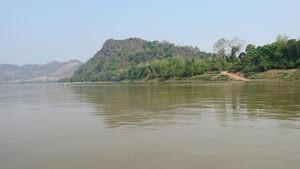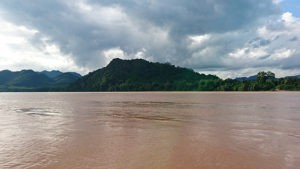People from temperate climates tend to think of Laos as a country that’s hot all year round with regular rainfall. Although this is true of some places in the tropics it’s not true of most, and certainly not of Laos. Although Laos doesn’t have the four seasons of temperate climes (spring, summer, autumn, winter) it does most definitely have seasons.

The gardens are lush with the current rains.
There is a dry, cool season from October – March, a hot season with some rain from April – June and then a warm, wet season from July – September. As you’d expect, these weather changes result in some serious environmental and floral changes too.
Many herbaceous plants here are dormant during the dry season, meaning they lose all their leaves and stems and persist only under the ground as rhizomes, bulbs, corms or roots. Many of the gingers behave in this manner. There are other species that lose their leaves and persist as dead-looking bits of stem until the rains come again, when they burst into life.
Semi-deciduous plants (those that lose their leaves for a brief time, almost immediately making new growth), particularly trees, are very common here. Towards the end of the dry season, when they’ve gone 5-6 months without rain, they drop all their leaves and quickly bring on a new flush in time for the rains to start. It’s quite a sight to see when a previously brown, dead looking bit of forest becomes a verdant green sea almost overnight – just add water!

Pha Tad Ke Mountain in the dry season…
These different seasons provide different challenges to the horticulturalist and botanist. In the dry, cool season the conditions are great for people, but not so much for plants. The roads are dry, solid and in reasonable condition. Access to remote areas is as good as it gets, mosquito numbers are down and you won’t be sweating before you’ve even started your trek into the forest. However, the plants are not looking so hot. It’s pretty much impossible to find gingers in this season, never mind collect them or study them. Equally impossible is identifying most other species, as lack of leaves and flowers prevents one from getting very far.

… the same mountain in the wet ‘green’ season.
The ground is hard as a rock, and equally dry, so trying to plant anything out or move anything around is not a good idea. This is the season for watering, watering and more watering. Here at PTK we spend most of the dry season doing just that!
On the other end of the scale, the rains bring out the best in the plants, and for me, as a botanist, this is the best time of year. There are lots of leaves and flowers to use for taxonomic work, it’s the best time to do surveys and look for interesting things. However, the roads are terrible (often completely impassable in fact) and the mosquitoes and mud are out in force. A recent field trip saw me covered in mud from head to toe within 1 hour, sweating profusely and still struggling to beat off the insects, despite covering up and using copious amounts of repellent. We got to see some great plants though, so it was all worth it.

In the Ginger family, this Kaempferia started to flower when the rains kicked in.
Our horticultural staff are currently gumboot-clad and frequently getting rained on, but planting, propagating and garden installation is happening a-pace. The botanic gardens are at their absolute best, all beautifully lush, our orchids are blooming left, right and centre, and the fruit are ripe for the picking.
I think people are put off visiting outdoor attractions like botanic gardens in the rain, but this is often when they’re most attractive. So don’t let a bit of water stop you – get out and enjoy your nearby gardens whatever the weather.
By Bryony Smart, PTK Botanist.


